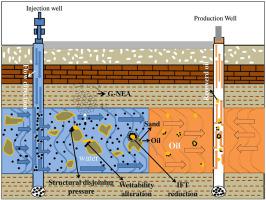Journal of Petroleum Science and Engineering ( IF 5.168 ) Pub Date : 2020-07-03 , DOI: 10.1016/j.petrol.2020.107602 Ehsan Jafarbeigi , Ehsan Kamari , Farhad Salimi , Akbar Mohammadidoust

|
One of the effective methods in the process of enhancing the oil recovery from oil reservoirs is the use of nanotechnology. For this purpose, a new nanofluid was used to enhance the oil recovery from the reservoir at the scale of carbonate rocks. Finally, the obtained compound, in the first stage, nano-graphene oxide (NGO) were synthesized using Hummer's method and then they were subjected to surface modifications under new compounds. Finally, the obtained compound was known as (graphene oxide (N-(1-naphthyl) ethylenediamine)) (G-NEA), where G stands for graphene oxide (GO). Also, to determine the morphological characteristics and structure of the synthesized nanoparticles, Field Emission Scanning Electron Microscopy (FESEM), Fourier-transform infrared spectroscopy (FTIR), and Transmission electron microscopy (TEM) were performed. In addition, zeta-potential analysis was performed to investigate the stability of nanofluids at different pHs. In order to investigate the effect of nanofluids on oil recovery, three concentrations (200, 400, and 500 ppm) of G-NEA nanofluids were prepared. Also, the interfacial-tension (IFT) measurement and rock angle measurement in the presence of nanofluid were investigated using a pendant drop and sessile drop method, respectively. The coreflood experiment was performed to evaluate the effect of G-NEA nanofluid on carbonate plugs. The results showed that when the G-NEA nanofluid concentration increased, the IFT value of 19.34 (mN/m) for deionized water to 10.8 (mN/m) for 500 ppm G-NEA and the contact angle decreased from the initial value of 166° to 40°, indicating the tendency of the wettability alteration of the rock to a water-wet conditions. The results of the coreflood experiment showed that at 400 and 500 ppm concentrations, the G-NEA nanofluid enhanced the oil recovery by 23 and 15%, respectively. Therefore, this synthesized nanofluid can have an effective approach to drive the carbonate reservoir rock into a water-wet condition and enhance oil recovery.
中文翻译:

新型纳米颗粒增强碳酸盐多孔介质中油采收率的实验研究
增强从油藏中采油的过程中的有效方法之一是使用纳米技术。为此,使用了一种新型的纳米流体来增强碳酸盐岩规模的储层的采油率。最后,首先使用Hummer方法合成得到的化合物纳米氧化石墨烯(NGO),然后在新化合物的作用下对其进行表面改性。最后,所得化合物称为(氧化石墨烯(N-(1-萘基)乙二胺))(G-NEA),其中G代表氧化石墨烯(GO)。另外,为了确定合成的纳米颗粒的形态特征和结构,进行了场发射扫描电子显微镜(FESEM),傅立叶变换红外光谱(FTIR)和透射电子显微镜(TEM)。此外,进行ζ电势分析以研究纳米流体在不同pH下的稳定性。为了研究纳米流体对石油采收率的影响,制备了三种浓度(200、400和500 ppm)的G-NEA纳米流体。此外,分别使用悬滴法和无滴法研究了存在纳米流体时的界面张力(IFT)测量和岩石角度测量。进行岩心驱油实验以评估G-NEA纳米流体对碳酸盐塞的影响。结果表明,当G-NEA纳米流体浓度增加时,去离子水的IFT值为19.34(mN / m),500 ppm G-NEA的IFT值为10.8(mN / m),接触角从初始值166减小°至40°,表明岩石在水湿条件下的润湿性变化趋势。岩心驱油实验的结果表明,在400和500 ppm浓度下,G-NEA纳米流体分别提高了23%和15%的采油率。因此,这种合成的纳米流体可以具有有效的方法来将碳酸盐储层岩石驱至水湿状态并提高采油率。



























 京公网安备 11010802027423号
京公网安备 11010802027423号